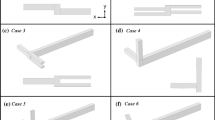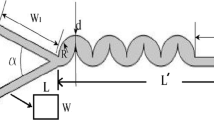Abstract
In microfluidics mixing of different fluids is a highly non-trivial task due to the absence of turbulence. The dominant process allowing mixing at low Reynolds number is therefore diffusion, thus rendering mixing in plain channels very inefficient. Recently, passive chaotic micromixers such as the staggered herringbone mixer were developed, allowing efficient mixing of fluids by repeated stretching and folding of the fluid interfaces. The optimization of the geometrical parameters of such mixer devices is often performed by time consuming and expensive trial and error experiments. We demonstrate that the application of the lattice Boltzmann method to fluid flow in highly complex mixer geometries together with standard techniques from statistical physics and dynamical systems theory can lead to a highly efficient way to optimize micromixer geometries. The strategy applies massively parallel fluid flow simulations inside a mixer, where massless and non-interacting tracer particles are introduced. By following their trajectories we can calculate finite time Lyapunov exponents in order to quantify the degree of chaotic advection inside the mixer. The current report provides a review of our results published in (Sarkar, Narváez, and Harting, 2010) together with additional details on the simulation methodology.
Access this chapter
Tax calculation will be finalised at checkout
Purchases are for personal use only
Preview
Unable to display preview. Download preview PDF.
Similar content being viewed by others
References
A. Sarkar, A. Narváez, and J. Harting. Quantification of the degree of mixing in chaotic micromixers using finite time Lyapunov exponents. Submitted for publication, arXiv:1012.5549, 2010.
M. A. Burns. Microfabricated structures for integrated DNA analysis. Proc. National Acad. Sci. USA, 68(93):5556–5561, 1996.
P. Watts and S. Haswell. Microfluidic combinatorial chemistry. Curr. Opin. Chem. Biol., 7:380–387, 1996.
V. Hessel, H. Loewe, and F. Schoenfeld. Micromixers—A review on active and passive mixing principles. Chem. Eng. Sci., 60:2479–2501, 2005.
H. Aref. Stirring by chaotic advection. J. Fluid Mech., 143:1–21, 1984.
H. Kim and A. Beskok. Quantification of chaotic strength and mixing in a micro fluidic system. J. Micromech. Microeng., 17:2197–2210, 2007.
C. Zhang, D. Xing, and Y. Li. Micropumps, microvalves and micromixers within pcr microfluidic chips: Advances and trends. Biotech. Advances, 25:483–514, 2007.
F. G. Bessoth, A. de Mello, and A. Manz. Microstructure for efficient continuous flow mixing. Analyt. Comm., 36:213–215, 1999.
D. Gobby, P. Angeli, and A. Gavriliidis. Mixing characteristics of a T-type microfluidic mixers. J. Micromech. Microeng., 11:126–132, 2001.
Y. Mingquiang and H. Bau. The kinematics of bend-induced stirring in micro-conduits. In Proc. ASME Intl. Mech. Sys. (MEMS’97), Nagoya, Japan, pp. 96–101, 2000.
A. Strook, S. Dertinger, A. Adjari, I. Mezic, H. Stone, and G. Whiteside. Chaotic mixer for microchannels. Science, 295:647–651, 2002.
T. K. Kang, M. K. Singh, T. H. Kwon, and P. D. Anderson. Chaotic mixing using periodic and aperiodic sequences of mixing protocols. Microfluids and Nanofluids, 4(6):589–599, 2007.
C. Ziemann, L. A. Smith, and J. Kurths. Localized Lyapunov exponents and the prediction of predictability. Phys. Lett. A, 4:237–251, 2000.
G. Lapeyre. Characterization of finite-time Lyapunov exponents and vectors in two-dimensional turbulence. Chaos, 12(3):688–698, 2002.
S. Succi. The Lattice Boltzmann Equation for Fluid Dynamics and Beyond. Oxford University Press, London, 2001.
Y. H. Qian, D. d’Humieres, and P. Lallemand. Lattice BGK models for Navier-Stokes equation. Europhys. Lett., 17(6):479–484, 1992.
P. Bhatnagar, E. Gross, and M. Krook. A model for collision process in gases. Small amplitude process in charged and neutral one-component systems. Phys. Rev., 94:511–525, 1954.
D. Ruiquiang and L. Jianping. Nonlinear finite-time Lyapunov exponent and predictability. Phys. Lett. A, 364:396–400, 2007.
X. Tang and A. Boozer. Finite time Lyapunov exponent and chaotic advection-diffusion equation. Physica D, 95:283–305, 1996.
Y. Lee, C. Shih, P. Tabeling, and C.-M. Ho. Experimental study and non-linear dynamics of time-periodic micro chaotic mixers. J. Fluid Mech., 575:425–448, 2007.
A. Wolf, J. B. Swift, H. L. Swinney, and J. A. Vastano. Determining Lyapunov exponents from a time series. Physica D, 16:285–317, 1985.
X. Shan and H. Chen. Lattice Boltzmann model for simulating flows with multiple phases and components. Phys. Rev. E, 47(3):1815, 1993.
X. Shan and H. Chen. Simulation of nonideal gases and liquid-gas phase transitions by the lattice Boltzmann equation. Phys. Rev. E, 49(4):2941, 1994.
H. Chen, B. M. Boghosian, P. V. Coveney, and M. Nekovee. A ternary lattice Boltzmann model for amphiphilic fluids. Proc. R. Soc. Lond. A, 456:2043, 2000.
J. Harting, M. Harvey, J. Chin, M. Venturoli, and P. V. Coveney. Large-scale lattice Boltzmann simulations of complex fluids: Advances through the advent of computational grids. Phil. Trans. R. Soc. Lond. A, 363:1895–1915, 2005.
G. Giupponi, J. Harting, and P. V. Coveney. Emergence of rheological properties in lattice Boltzmann simulations of gyroid mesophases. Europhys. Lett., 73:533–539, 2006.
N. González-Segredo, J. Harting, G. Giupponi, and P. V. Coveney. Stress response and structural transitions in sheared gyroidal and lamellar amphiphilic mesophases: Lattice-Boltzmann simulations. Phys. Rev. E, 73:031503, 2006.
A. Narváez, T. Zauner, F. Raischel, R. Hilfer, and J. Harting. Quantitative analysis of numerical estimates for the permeability of porous media from lattice-Boltzmann simulations. J. Stat. Mech: Theor. Exp., 2010:P211026, 2010.
A. Narváez and J. Harting. A D3Q19 lattice-Boltzmann pore-list code with pressure boundary conditions for permeability calculations. Advances in Applied Mathematics and Mechanics, 2:685, 2010.
J. Chin, J. Harting, S. Jha, P. V. Coveney, A. R. Porter, and S. M. Pickles. Steering in computational science: Mesoscale modelling and simulation. Contemporary Physics, 44(5):417–434, 2003.
J. Harting, C. Kunert, and H. Herrmann. Lattice Boltzmann simulations of apparent slip in hydrophobic microchannels. Europhys. Lett., 75:328–334, 2006.
C. Kunert and J. Harting. Roughness induced apparent boundary slip in microchannel flows. Phys. Rev. Lett., 99:176001, 2007.
J. Hyväluoma and J. Harting. Slip flow over structured surfaces with entrapped microbubbles. Phys. Rev. Lett., 100:246001, 2008.
C. Kunert, J. Harting, and O. I. Vinogradova. Random-roughness hydrodynamic boundary conditions. Phys. Rev. Lett., 105:016001, 2010.
A. Komnik, J. Harting, and H. J. Herrmann. Transport phenomena and structuring in shear flow of suspensions near solid walls. J. Stat. Mech: Theor. Exp., P12003, 2004.
M. Hecht, J. Harting, T. Ihle, and H. J. Herrmann. Simulation of claylike colloids. Phys. Rev. E, 72:011408, 2005.
J. Harting, H. J. Herrmann, and E. Ben-Naim. Anomalous distribution functions in sheared suspensions. Europhys. Lett., 83:30001, 2008.
F. Janoschek, F. Toschi, and J. Harting. Simplified particulate model for coarse-grained hemodynamics simulations. Phys. Rev. E, 82:056710, 2010.
F. Jansen and J. Harting. From Bijels to Pickering emulsions: A lattice Boltzmann study. Phys. Rev. E, 83:046707, 2011.
D. Groen, O. Henrich, F. Janoschek, P. Coveney, and J. Harting. Lattice-Boltzmann methods in fluid dynamics: Turbulence and complex colloidal fluids. In W. F. Bernd Mohr, editor, Jülich Blue Gene/P Extreme Scaling Workshop 2011. Jülich Supercomputing Centre, 52425 Jülich, Germany, apr 2011. FZJ-JSC-IB-2011-02; http://www2.fz-juelich.de/jsc/docs/autoren2011/mohr1/.
J. Harting, F. Jansen, S. Frijters, F. Janoschek, and F. Günther. Nanoparticles as emulsion stabilizers. inSiDE, 9(1):48, 2011.
A. D. Stroock and G. J. McGraw. Investigation of the staggered herringbone mixer with a simple analytical model. Phil. Trans. R. Soc. Lond. A, 362:923–935, 2004.
C. Li and T. Chen. Simulation and optimization of chaotic micromixer using lattice Boltzmann method. Sensors and Actuators B, 106:871–877, 2005.
Author information
Authors and Affiliations
Editor information
Editors and Affiliations
Rights and permissions
Copyright information
© 2012 Springer-Verlag Berlin Heidelberg
About this paper
Cite this paper
Sarkar, A., Narváez, A., Harting, J. (2012). Optimization of Chaotic Micromixers Using Finite Time Lyapunov Exponents. In: Nagel, W., Kröner, D., Resch, M. (eds) High Performance Computing in Science and Engineering '11. Springer, Berlin, Heidelberg. https://doi.org/10.1007/978-3-642-23869-7_24
Download citation
DOI: https://doi.org/10.1007/978-3-642-23869-7_24
Publisher Name: Springer, Berlin, Heidelberg
Print ISBN: 978-3-642-23868-0
Online ISBN: 978-3-642-23869-7
eBook Packages: Mathematics and StatisticsMathematics and Statistics (R0)




